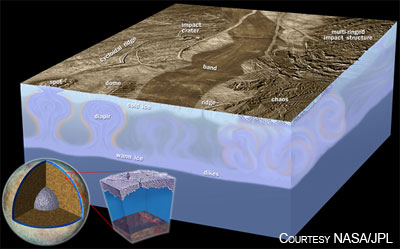Judging a book by its cover:
Inferring the plumbing of Europa's icy shell
from surface geology
By:
Wes Patterson
John Hopkins University, Applied Physics Lab

| When: | Friday, April 19, 2013, 10:30 a.m. to 11:30 a.m. Join us for coffee beginning at 10:00 a.m. |
| Where: | Seminar Conference Room, 10100 Burnet Road, Bldg 196-ROC, Austin, Texas 78758 |
| Host: | Britney Schmidt, UTIG |
Click for a Live Broadcast.
Abstract
The Galileo mission to Jupiter and the Cassini mission to Saturn have revolutionized our understanding of icy satellites but have also left us with a number of open questions. From a geologic perspective, the role of cryovolcanism/magmatism in the formation and evolution of icy satellite surfaces is primary among them.
On Earth, hydrostatic pressure is capable of bringing mafic and silicic magmas to the surface. For icy satellites, hydrostatic pressure is sufficient to bring icy 'magma' to the surfaces of bodies the size of Enceledus but not to bodies the size of Europa.
Hence, evidence for cryovolcanism among the icy Galilean satellites has been sparse, while active jetting from the south pole of Enceladus has been observed. Does this mean that the outer ice shells of bodies like Europa harbor, or have harbored, intrusive bodies of water or briney material? More specifically, having only remotely sensed data, is it possible to infer the presence of intrusive/cryomagmatic bodies within the outer shells of icy satellites?
Topographic information for two prominently observed morphologies on the Galilean satellite Europa - double ridges and chaos - suggest the answer is yes.
On the figure, the color shows the peak ground velocity during a simulation of an M9 earthquake along the Pacific Northwest coastline. Image credit: Kim Olson




